Resistor are marked with a color code indicating "Resistance Value" or "Resistance Tolerance".
Regarding the Resistor, this article will explain the information below.
- Chart of Resistor Color Code
- How to Read Resistor Color Code
Chart of Resistor Color Code
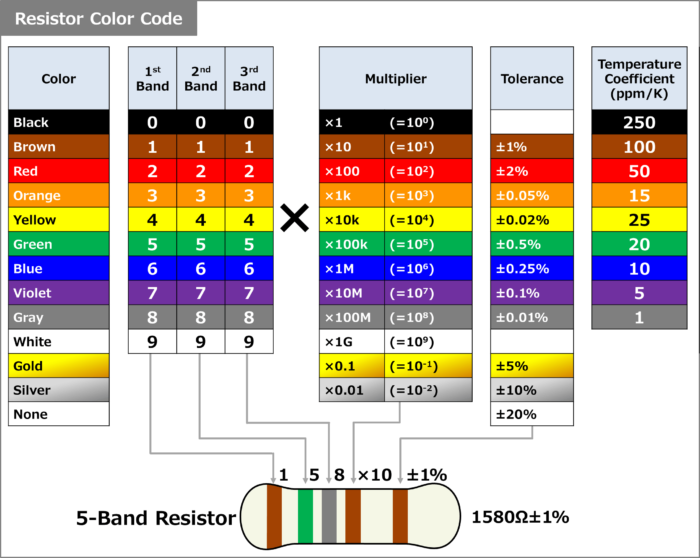
The color code chart for resistor is shown above.
Each color code for resistor has a corresponding number. For example, black is "0", brown is "1", and red is "2".
Next, we will explain how to read resistance values using the resistor color code chart.
How to Read Resistor Color Code
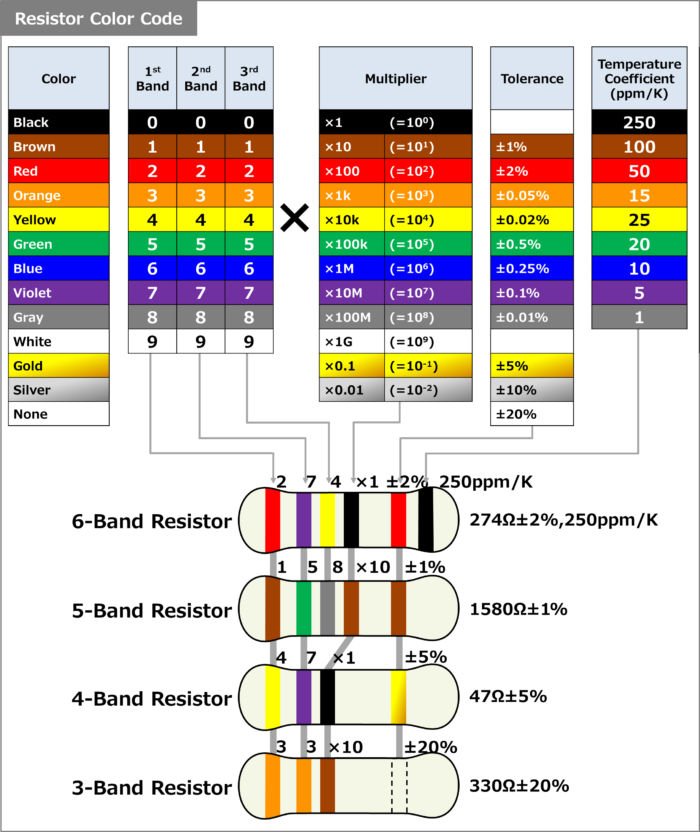
The color code chart of resistors and each resistor (3-band resistor to 6-band resistor) are shown in the figure above.
The number of bands on a resistor ranges from 3 to 6. The most common types are "4-band resistor" and "5-band resistor".
For the multiplier, assign the numerical value of the color code to the "■ place of 10■". For example, black represents "1", so "100=1x", and red represents "2", so "102=100x". In addition, gold and silver are added to the multiplier: "10-1=0.1x" for gold and "10-2=0.01x" for silver
Now let's actually read the resistance values for 3-band to 6-band resistors.
3-Band Resistor Color Code
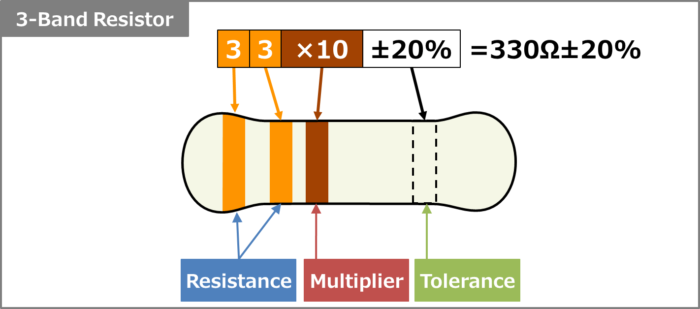
For 5-band resistor, the 1st and 2nd bands represent "resistance" and the 3rd band represents "multiplier".
Looking at the 3-band resistor color code in the figure above, we see that from left to right, the color code is "Orange → Orange → Brown". This means the following:
- Resistance
- The color code is "Orange(3) → Orange(3)", which means "33".
- Multiplier
- The color code is "Brown(1)", which means "101=10x".
Therefore, the 3-band resistor (Orange → Orange → Brown) means "33×101=330Ω". Also, for the 3-band resistors, the resistance tolerance is "±20%".
4-Band Resistor Color Code
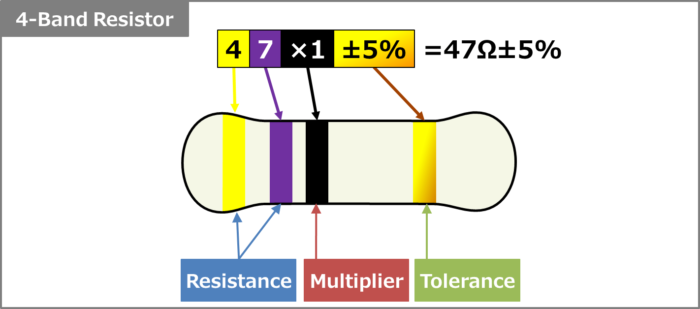
For 4-band resistor, the 1st and 2nd bands represent "resistance", the 3rd band represents "multiplier", and the 4th band represents "resistance tolerance".
Looking at the 4-band resistor color code in the figure above, we see that from left to right, the color code is "Yellow → Violet → Black → Gold". This means the following:
- Resistance
- The color code is "Yellow(4)→Violet(7)", which means "47".
- Multiplier
- The color code is "Black(0)", which means "100=1x".
- Resistance Tolerance
- The color code is "Gold", which means "±5%".
Therefore, the 4-band resistor (Yellow → Violet → Black → Gold) means "47×100±5%=47Ω±5%".
Supplement
- 4-band resistor is the most common resistor.
- Since the tolerance for 4-band resistor is generally 5%, the 4th band is often "Gold".
5-Band Resistor Color Code
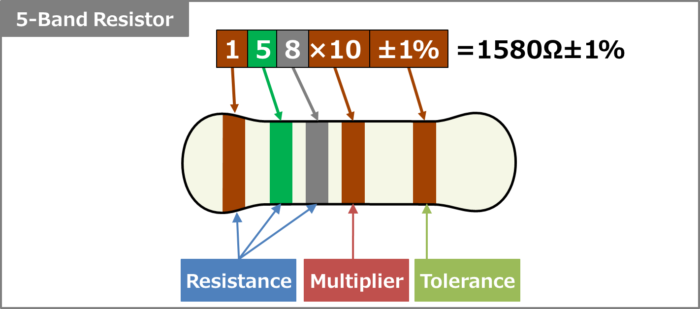
For 5-band resistor, the 1st to 3rd bands represent "resistance", the 4th band represents "multiplier", and the 5th band represents "resistance tolerance".
Looking at the 5-band resistor color code in the figure above, we see that from left to right, the color code is "Brown → Green → Gray → Brown → Brown". This means the following:
- Resistance
- The color code is "Brown(1) → Green(5) → Gray(8)", which means "158".
- Multiplier
- The color code is "Brown(1)", which means "101=10x".
- Resistance Tolerance
- The color code is "Brown(1)", which means "±1%".
Therefore, the 5-band resistor (Brown → Green → Gray → Brown → Brown) means "158×101±1%=1580Ω±1%=1.58kΩ±1%".
Supplement
- Since the tolerance for 5-band resistor is generally 1%, the 5th band is often "Brown(1)".
6-Band Resistor Color Code
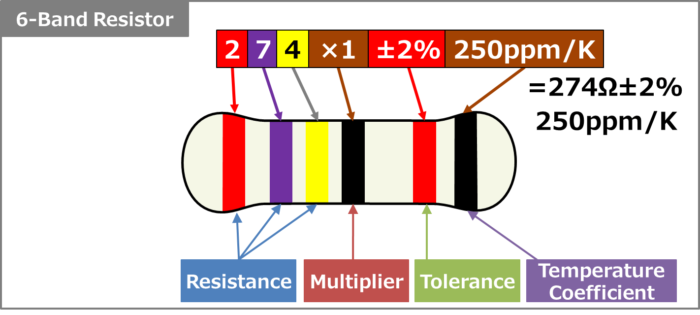
For 6-band resistor, the 1st to 3rd bands represent "resistance", the 4th band represents "multiplier", the 5th band represents "resistance tolerance", and the 6th band represents "Temperature Coefficient".
Looking at the 6-band resistor color code in the figure above, we see that from left to right, the color code is "Red → Violet → Yellow → Black → Red → Black". This means the following:
- Resistance
- The color code is "Red(2) → Violet(7) → Yellow(4)", which means "274".
- Multiplier
- The color code is "Black(0)", which means "100=1x".
- Resistance Tolerance
- The color code is "Red(2)", which means "±2%".
- Temperature Coefficient
- The color code is "Black(0)", which means "250ppm/K".
Therefore, the 6-band resistor (Red → Violet → Yellow → Black → Red → Black) means "274×100±2%, 250ppm/K=274Ω±2%, 250ppm/K".
Supplement
- Since the temperature coefficient for 6-band resistor is generally 100ppm/K, the 6th band is often "Brown(1)".
Color Code of Carbon Resistor and Metal Film Resistor
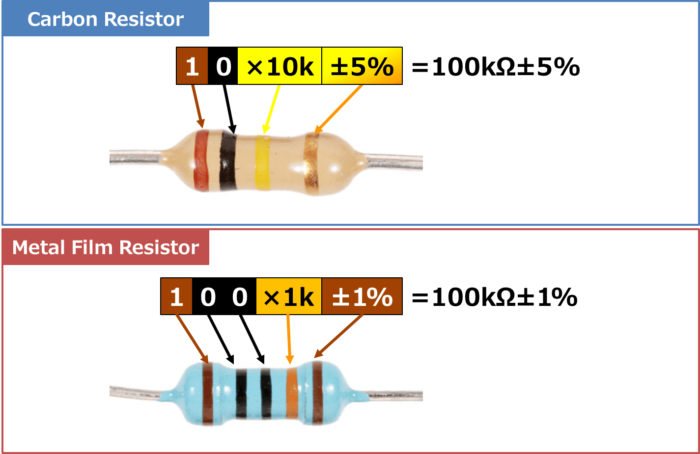
Shown in the figure above are "Carbon Resistor" and "Metal Film Resistor". Read the resistance value from the color code.
Carbon Resistor
The carbon resistor shown in the figure above is a 4-band resistor, we see that from left to right, the color code is "Brown → Black → Yellow → Gold". This means the following:
- Resistance
- The color code is "Brown(1) → Black(0)", which means "10".
- Multiplier
- The color code is "Yellow(4)", which means "104=10000x=10kx".
- Resistance Tolerance
- The color code is "Gold", which means "±5%".
Therefore, the carbon resistor (Brown → Black → Yellow → Gold) means "10×104±5%=10×10k±5%=100kΩ±5%".
Metal Film Resistor
The metal film resistor shown in the figure above is a 5-band resistor, we see that from left to right, the color code is "Brown → Black → Black → Orange → Brown". This means the following:
- Resistance
- The color code is "Brown(1) → Black(0) → Black(0)", which means "100".
- Multiplier
- The color code is "Orange(3)", which means "103=1000x=1kx".
- Resistance Tolerance
- The color code is "Brown(1)", which means "±1%".
Therefore, the metal film resistor (Brown → Black → Black → Orange → Brown) means "100×103±1%=100×1k±1%=100kΩ±1%".
Zero-ohm Resistor Color Code

The color code for the zero-ohm resistor is shown in the figure above.
As shown here, only a black band is used, which is highly visible and can be easily recognized on the board.
Summary
This article described the following information about "Resistor".
- Chart of Resistor Color Code
- How to Read Resistor Color Code
Thank you for reading.